Fortress Oreshek. 500 days of defense
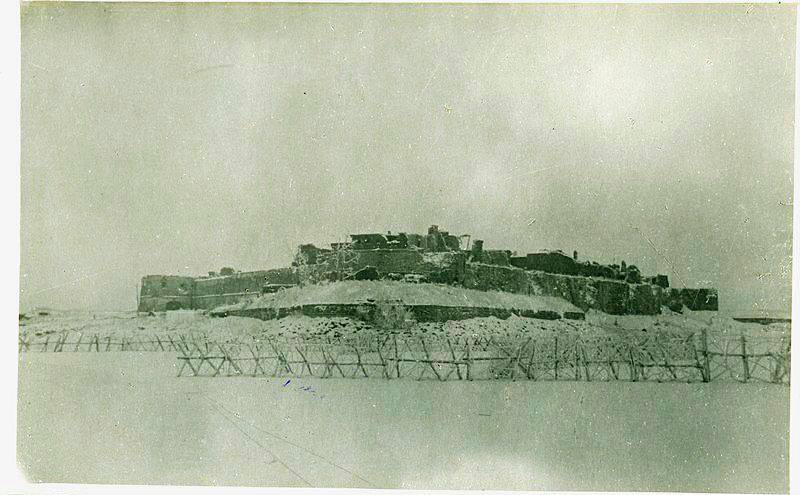
Fortress Oreshek after all shelling in 1943
Founded back in 1323 by Novgorodians, the Oreshek fortress became an important stronghold at the source of the Neva for many years. During the Great Patriotic War, a small garrison of Soviet troops defended the fortress for almost 500 days, to be exact, 498 days before the break of the blockade of Leningrad in January 1943.
During the defense, about 50 thousand enemy shells and mines fell on the heads of the defenders of the ancient fortress, while the Germans also bombed the fortress from the air. The fortress, located at the source of the Neva near Shlisselburg, for hundreds of days turned into an advanced outpost for the defense of the left flank of the Leningrad Front.
The presence of the fortress and a permanent garrison of its defenders prevented the Germans from crossing the Neva in this place and reaching the western bank of Ladoga. Similar plans were being worked out by the German command. For Leningrad, the exit of the Germans to the western shore of Lake Ladoga would have ended in disaster, since it was through Ladoga that the city was supplied with food and ammunition. The Road of Life worked here both in winter and in summer. During navigation - on water, in winter - on the ice of the lake.
Fortress history
The Oreshek fortress was founded in 1323 by the Novgorodians, it got its name in honor of the Orekhovy Island, on which it was located. The fortress was founded by Prince Yuri Danilovich, who is the grandson of the legendary Alexander Nevsky. In the same year, the first treaty between Novgorodians and Swedes was signed on Orekhovy Island. stories name Orekhovsky world. For many years the fortress turned into an outpost between Sweden and the Novgorod lands, and then the Moscow principality.
In the period from 1612 to 1702, the fortress was occupied by the Swedes, but then again recaptured by the Russians during the Northern War. The Swedes also called the fortress Noteburg (nut city). With the construction of Kronstadt, the fortress at the source of the Neva lost much of its military significance, so in 1723 it was transformed into a political prison.
Since 1907, the Oreshek fortress was used as a central convict prison. In the same years, the reconstruction of the old and the construction of new buildings took place here. Among the famous prisoners of the fortress was Lenin's brother, Alexander Ulyanov, who was executed here, who attempted to assassinate Emperor Alexander III. In the last years of the empire's existence, well-known political prisoners were kept here, including populists, Socialist-Revolutionaries and terrorists, a large contingent of prisoners was made up of Poles.
The Oreshek fortress itself occupied the entire territory of the Orekhovoy Island. Externally and on the plan, it is an irregular triangle, which is noticeably elongated from east to west. Towers were located along the perimeter of the fortress walls. There were seven of them around the perimeter of the fortress, one of them, called Vorotnaya, was quadrangular, the rest round. Three more towers were internal and defended the citadel. Of these ten towers, only six have survived to this day in a different state.
The fortress, founded in the XIV century, was rebuilt many times, having survived until the beginning of the Great Patriotic War. At the same time, during the hostilities, she was badly damaged due to shelling. Almost all buildings built by that time on the territory of the fortress were badly destroyed or damaged, the same applied to the walls and towers.
The beginning of the defense of the fortress Oreshek
On the night of September 7, 1941, Hitler's troops reached Shlisselburg, and the next day they finally occupied the city. With this step, they cut off all existing ground communications of Leningrad with the rest of the country, and traffic along the Neva was also blocked. Soviet troops retreated to the right bank of the river and settled there, relying on a water barrier. At the same time, the Oreshek fortress remained empty for a while. For some reason, the Germans ignored this object, perhaps believing that they could control all approaches to the fortress with fire, which was several hundred meters from the side of Shlisselburg.
Soviet troops, retreating to the right bank of the Neva, already on the night of September 9, sent reconnaissance to the fortress as part of two platoons of the 1st division of the NKVD troops, commanded by Colonel Donskov. By dawn they reached the fortress and surveyed the island, the fortress was not occupied by the enemy. The soldiers immediately organized a perimeter defense and began to wait for reinforcements.
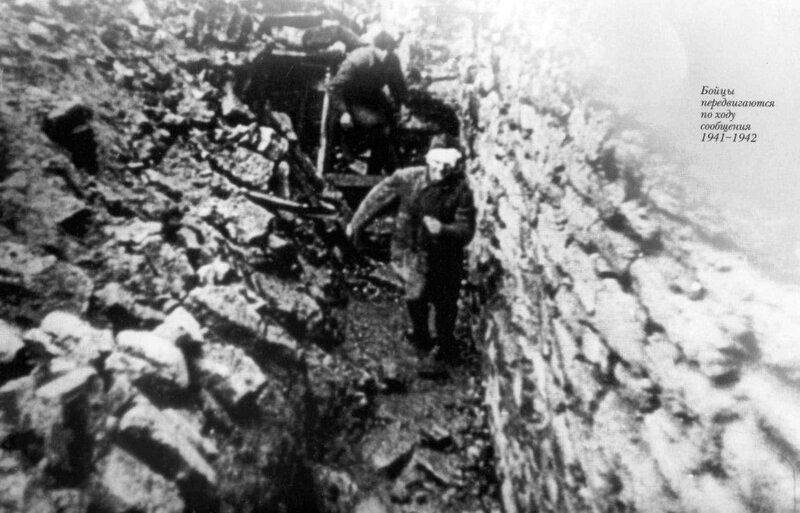
The next day, September 10, the Oreshek fortress was inspected by high-ranking officials of the command, headed by the representative of the Military Council of the Leningrad Front, General Semashko, the commander of the 1st division of the NKVD troops, Colonel Donskov and Captain Chugunov, who, as a result, was appointed the first commandant of the fortress. Already on September 11, an order was signed to create a permanent garrison in the fortress, the basis of which was to be formed by the soldiers of the NKVD division.
This division was formed in August 1941, mainly from border guards. The size of the garrison was determined at 300 people. The main task that was set before the garrison of the fortress was to prevent a possible crossing of German troops to the right bank of the Neva in this area. Apparently, the fortress was considered not only as an important stronghold of the defense, but also as an important object for subsequent operations to capture Shlisselburg.
The Soviet command made such attempts as early as September 1941. On September 20, the division fighters tried to land south of the city near the mouth of the Chernaya Rechka, but failed, most of the landing was destroyed. On September 26, another attempt was made, this time the landing force landed in the city itself in the area of the Sheremetyevskaya pier. Two companies of the 2nd regiment of the division, which were fighting in the northwestern part of the city, were able to cross; on September 27, a reconnaissance platoon of the regiment was also landed to help them.
The further fate of the landing remains unknown, apparently, it was completely defeated by the enemy. The 1st Rifle Division of the NKVD troops did not make more attempts to cross in the Shlisselburg area. At the same time, the garrison of the Oreshek fortress, from which it was less than 300 meters to the city, was reinforced with the 1941th naval battery in October 409. The battery then consisted of five 45-mm guns and about 60-65 personnel.
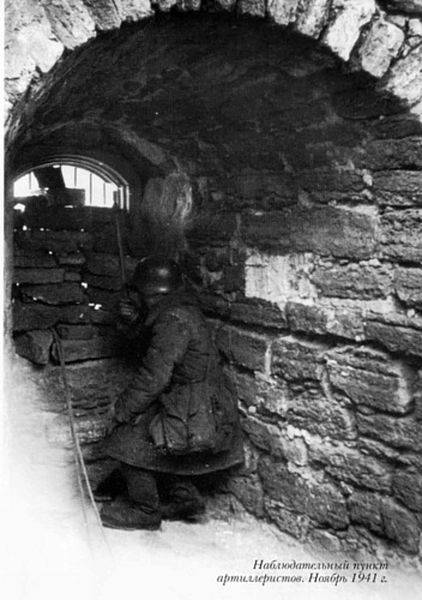
Despite the failure of the landing, the fortress proved to be important as a springboard for a possible offensive. In addition, it was a ready-made long-term firing point that provided fire support for the landing. From the fortress, the city was sufficiently shot through, it is no coincidence that in the future the sniper movement will become widespread in the division. Only by December 1941, the snipers operating in the fortress recorded at their own expense 186 killed Nazis.
Also, the active actions of the fortress garrison, which was sitting right next to the Germans, did not allow the enemy to transfer forces from this area to other directions, for example, to the Moscow Dubrovka area. It was here that Soviet troops at the end of September 1941 created a bridgehead on the left bank of the Neva, which went down in history as the Nevsky Piglet.
Everyday life of defenders
In November, another artillery battery was transferred to the fortress across the ice. The 409th battery took up positions in the northwestern part of the island. By that time, she had two 76-mm guns, five 45-mm cannons, two 50-mm mortars and 4 anti-tank guns. The battery also had 6 heavy machine guns. She alone represented a rather formidable force. The 61st Battery of the Leningrad Front, which arrived on the island, was located in the southeastern part of the island. She was armed with two 76 mm guns and three 45 mm guns.
There was enough firepower in the fortress; in addition to artillerymen and riflemen, there was also a mortar company here. The entire southern wall of the Oreshek fortress and the towers located here were equipped for firing points. The guns were raised on the walls and in the towers, while the soldiers lived and hid from shelling in the lower tiers of the towers, casemates, equipped dugouts and hidden communication passages.
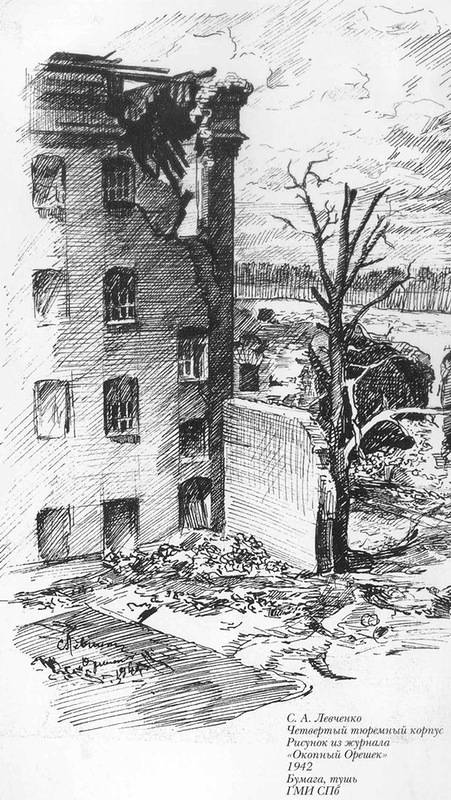
The presence of sufficiently large artillery forces, as well as machine guns, made it possible to periodically arrange fire raids on German positions. This very unnerved the Nazis, as well as the reconnaissance and sabotage sorties that were conducted from the fortress. Very often fire duels arose between the defenders of the fortress and the Germans. At the same time, the enemy outnumbered the Red Army in artillery. At the disposal of the Germans near Leningrad was a large number of heavy guns and howitzers, including siege weapons.
Shells and mines rained down on the fortress almost every day, sometimes the Germans fired on Oreshek literally on schedule at 7, 16 and 19 o'clock. In total, more than 50 thousand shells and mines were fired at the fortress. They made their first serious attempts to suppress the garrison and raze the fortress to the ground on September 21, 1941.
In the diary of a German officer, who was discovered after the liberation of Shlisselburg, the artillery shelling of the fortress in these days was described in paints. For XNUMX hours a red cloud of dust and smoke stood over the fortress, several dozen heavy guns were firing. Because of the cloud of brick dust that rose into the sky, practically nothing was visible, and the Germans themselves in the city became deaf from the sounds of explosions. Despite the terrible-looking consequences of the shelling, the fortress came to life again, from its walls they again opened fire on the areas of the city occupied by the Germans.
Another very large-scale shelling of the fortress took place on June 17, 1942. Then the Germans fired at the walls and towers for six hours, firing during this time 280 heavy shells and more than 1000 shells and mines of medium caliber. During such attacks, the garrison of the fortress inevitably suffered losses, and on June 17, in addition to the killed and wounded, the garrison temporarily lost 4 guns of the naval battery.
Fortress supply difficulties
The situation of the garrison was complicated by the fact that all supplies went through the Neva. Until there was ice on the river, ammunition and food were transported to the island on boats, in the same way they brought in replenishment and took the wounded. At the same time, the crossing was not safe, since the Germans kept it under machine-gun and mortar fire. It was especially difficult with supplies during the white nights, when even small objects on the river could be seen from a distance of a kilometer.
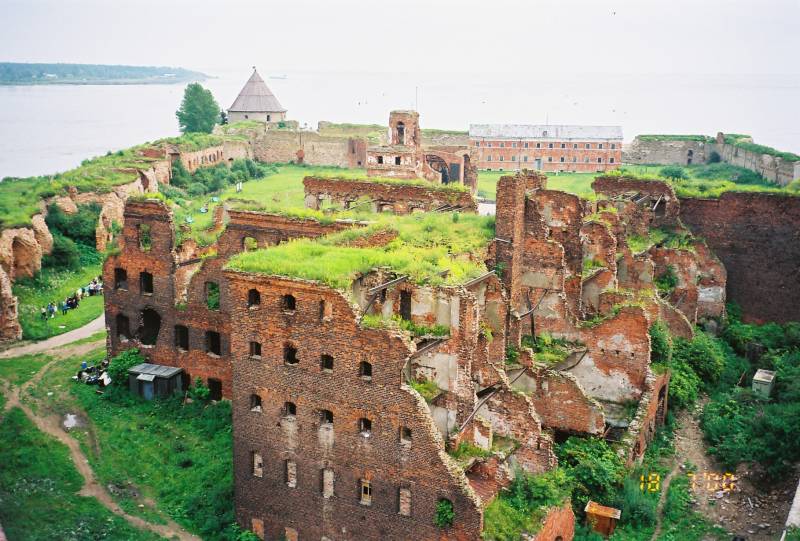
Internal view of the fortress, all the destruction was caused mainly by the battles of the Great Patriotic War.
Photo: Tretyakov Dmitry, wikipedia.org
As the boatmen recalled, it was almost impossible to get to the fortress on boats during the white nights. Most often it was possible to break through only in one direction. Moreover, the way from the fortress to the coast was easier than from the coast to the fortress. The Germans could keep the boats under targeted machine-gun fire only until the middle of the river, after which they switched to mortar fire when the boats were in the blind zone.
As a result, from time to time the defenders had difficulties with supplies. For example, in the spring of 1942, a real shell hunger was felt in the fortress, this is not to mention the usual hunger, since the food supply in that harsh winter of 1941-1942 and in the spring of 1942 was very meager both in the rear and in the units defending Leningrad ... To get shells, an expedition was undertaken to a barge that sank in the Neva in the fall of 1941.
The operation to raise the ammunition went on for several nights, while the volunteers did not just risk their lives, since the Germans could find them at any moment, they could simply drown while diving into cold water and looking for shells on the barge. Taking into account the low water temperature and the strong flow of the river, lifting the shells was a very difficult task. Despite all the difficulties, in a few nights the much-needed ammunition was transferred to the fortress, most of which turned out to be quite suitable for firing.
The epic with the defense of the fortress lasted until January 18, 1943. On this day, the city of Shlisselburg was liberated from the Germans by units of the 67th Army during Operation Iskra, which began on January 12. During the assault on the city, the attackers were supported by the garrison of the Oreshek fortress, which fired at the identified enemy firing points, suppressing them with artillery fire.
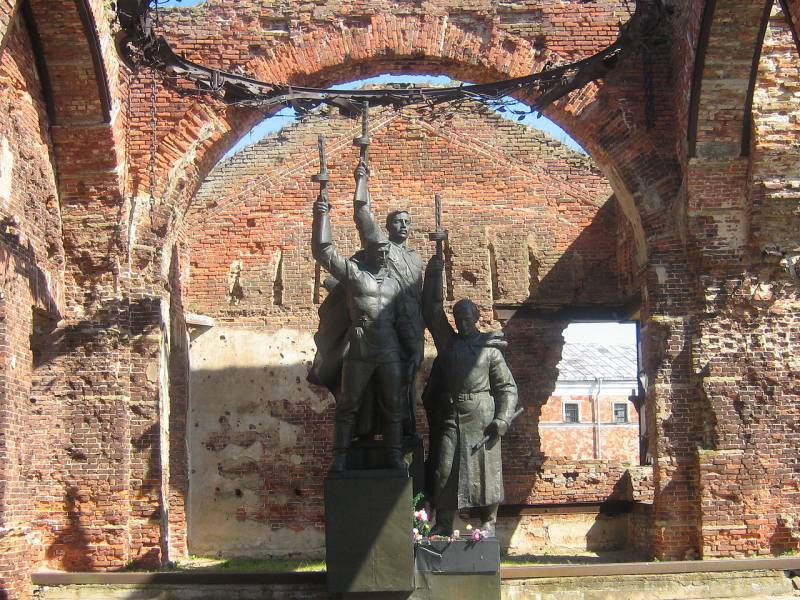
Monument to the defenders of the fortress during the Great Patriotic War in the destroyed church.
Source: wikipedia.org
According to various sources, during the days of the defense of the fortress, dozens of Soviet soldiers were killed in it. According to some sources, the number of killed and seriously wounded reached 115 people, according to others, the garrison of the fortress lost 500 people in almost 182 days of defense alone, dozens of soldiers were wounded and then evacuated from the fortress, many died during the crossings across the Neva.
Today the Oreshek fortress is a cultural heritage site of the peoples of the Russian Federation of federal significance, it is also included in the list of UNESCO World Heritage Sites. In 1985, a memorial complex dedicated to the events of the Great Patriotic War was solemnly opened on the territory of the fortress. Also on the territory there is a mass grave, in which the remains of 24 defenders of the fortress are buried. The fortress itself today is a museum and is open to tourists, as a branch of the State Museum of the History of St. Petersburg.
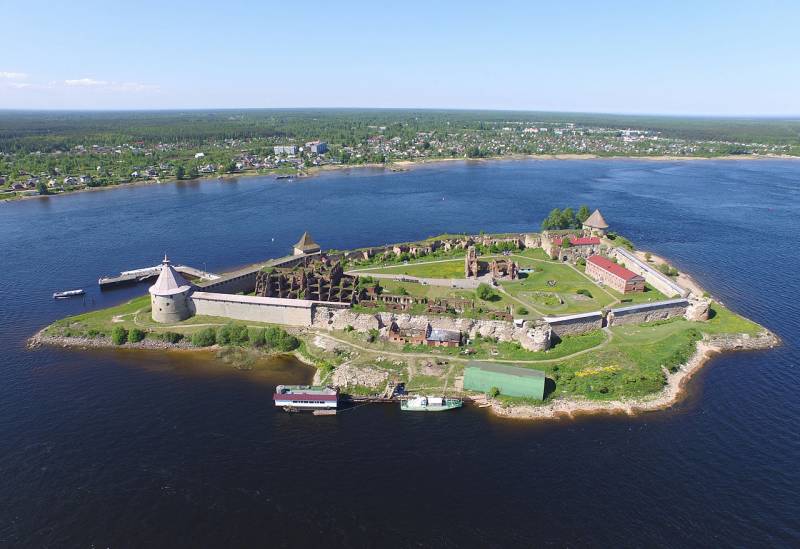
Information